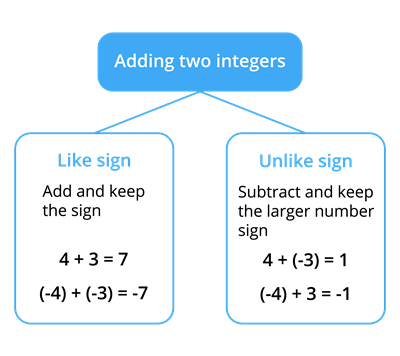PDF chapter test TRY NOW
If a number has no sign, then it is a positive number.
Example:
\(10\) means \(+10\).
\(56\) means \(+56\).
Rules for adding two integers:

The sum of two positive numbers is always a positive number.
1. Add \(5\) and \(10\).
Step 1: \(5\) and \(10\) both are positive numbers. That is like signs. So, add those numbers.
Step 2: Here, both numbers are like signs. So, the answer will also be in the same sign.
\(5 + 10 = 15\).
The sum of two negative numbers is always a negative number.
2. Add \((-25)\) and \((-3)\).
Step 1: \((-25)\) and \((-3)\) both are negative numbers. That is like signs. So, add those numbers.
Step 2: Here, both numbers are like signs. So, the answer will also be in the same sign.
\((-25) + (-3) = -28\).
The sum of positive and negative numbers keeps the sign of a larger number.
3. Add \(-56\) and \(23\).
Step 1: \(-56\) is a negative number and \(23\) is a positive number. That is unlike signs. So, subtract those numbers.
Step 2: Here, \(56\) is larger than \(23\). The sign of \(56\) is (\(-\))negative.
\((-56) + 23 = -33\).
